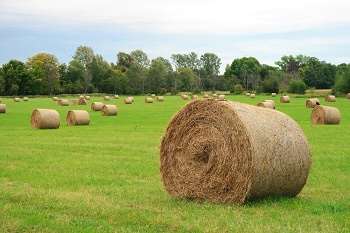By Katie Nichols
It’s no secret that the summers in Alabama are hot and dry. This year is no exception. Yards and pastures are suffering from heat stress.
An Alabama Extension Crop Specialist has recommendations for farmers struggling with weed suppression in pasture systems.
Weed Control in a Drought
Dr. Steve Li said weed control during a drought is typically very difficult.
“Under drought conditions, all plants slow down growth,” he said. “Plants will develop a thick cuticle and metabolism slows down. They will also try to close the stomata during the day to conserve water. After the stomata is closed, there is very little carbon dioxide in the plant and the photosynthetic rate drops significantly.”
Many herbicides target the photosynthetic process, so with a slowed rate of photosynthesis herbicides may not work as well.
Li said in a drought situation, producers should think twice before going to the sprayer.
“Weeds seem to grow in a quick flush after a rain,” Li said. “Instead of wasting a herbicide application on dry weeds, wait until after a rain to apply. You will most likely have healthier weeds to spray.”
It is important to use surfactant and ammonium sulfate during herbicide application. This will assist plant uptake of the herbicide. Consult the herbicide label for manufacturer requirements.
Whether there is rain or no rain, Li said one option for weed control is to mow the pasture. The weeds are still sensitive to leaf blade in any condition. Another option is to utilize irrigation in the pasture and hay field if it is available to you. A quick shower from the irrigation system would have a noticeable impact on plant uptake of herbicides.

When to Spray Perennial Weeds
Most farmers are familiar with perennial weeds causing issues on the farm. Blackberry and dewberry, ironweed, kudzu, passionflower, Chinese privet, Japanese honeysuckle, Cherokee rose, trifoliate orange and unwanted woody brush are good examples of perennial weeds that cause issues in pasture systems.
The most effective time to spray perennial weeds is in late summer and early fall. Later in the season perennial weeds will begin getting into the reproduction stage.
“Typically, plants are more sensitive to stress and herbicides in the reproductive stage as compared to earlier in the season when they are in the vegetative growth stage,” Li said.
Perennial plants will be making photosynthetic products later in the season and move them into reproductive organs. Spraying herbicide at this point in the year allows the herbicides to translocate into the storage organs of the plant along with the carbohydrates, amino acids and other photosynthetic products, giving the herbicide a better chance of killing the plant and prevent regrowth in future.
“In many cases, the storage organs are also reproductive organs,” he said. “If you don’t kill the storage organs, you do not kill the weed. Kudzu root is a classic example. This is one of the major challenges of perennial weed control. Preventing regrowth and continuous control effort are always required for successful perennial weed control.”
Other Considerations Herbicide Applications
Herbicide applications must be timely and carefully calculated. Spray drift is a factor that could cause lots of problems for sensitive row crops like soybean, cotton and vegetables. When spraying drift is a concern, always use large droplets, lower pressure (around 40 PSI), low driving speed (below 10 mph) and low boom height (18-20 inches above canopy) with a boom-type sprayer. Spray only when the wind speed is less than 10 mph and blowing away from the sensitive crop.
It is important to ensure good coverage. When spraying perennial weeds—especially brush-type weeds—the stand can be very thick, so increasing the sprayer output may help push the spray droplets through the dense canopy. If the weed stand is too thick, mowing may be required before applying herbicides.
“Repeated applications for perennial weed control is the key,” Li said. “You may start with 100 weed plants in one field, and after three years you may only have five plants left. If you do not do something to those five plants and turn them loose, they will grow back and multiply quickly.”
It is a constant battle to suppress the weed population. Weed eradication is difficult, but continuously controlling the population is better than the alternative of letting it run rampant in pastures and hay fields. Growing forage or hay and preventing overgrazing are also critical to weed control. Thin forage or hay, large bare ground and overgrazing always lead to future weed problem if there is a lack of weed-crop competition.
Source:aces.edu